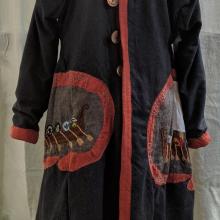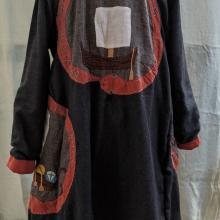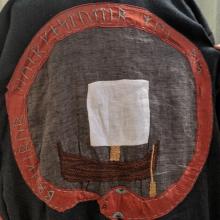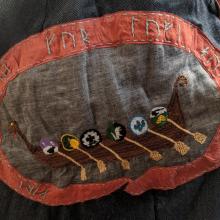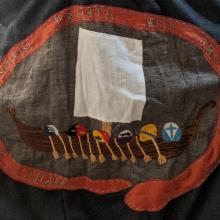This long coat is the culmination of several major projects for me in the SCA. The first is the embroidered ships adorning this coat, which were my first Kingdom AS entry and the largest embroidery project I have attempted to date. The second is the long coat itself which was drafted from the Haithabu tunic and is the second garment I have made with gores and gussets rather than a one-piece Scadian t-tunic pattern. Third the pattern I used to make each of the coats four layers was the first pattern that I have drafted completely independently.
The original inspiration of the project was from a book called, “The Age of Vikings”, which gave me the idea to try and recreate scaled images of different styles of long ship in embroidery. This idea resulted in the embroidered creations of Skuldelev 1, Skuldelev 2, and the Nydam Ship. The idea to apply the ships to a long coat when completed came about because I could not bear the thought of pieces that I had poured so many hours into sitting unused.
I did not have a vision for the long coat itself until several months ago, when I finally finished the Skuldelev 2 long ship. A few skills I attempted for the first time in the construction of the coat included: making a multi layered garment, embroidering runes, and sewing with silk.
Total this project has been in the works for four years. The ships took the lions share of the time at three and a half years to complete (that time includes several breaks where I had no interest in working on the project) and the long coat itself which took approximately 20 hours to complete.
To pattern this coat, I used the Haithabu tunic, named because it is housed in the Haithabu Viking Museum which is near the site of Hedeby/Haithabu. The museum houses many finds from this town. To transform the tunic into a long coat, I cut open the front center of the tunic to make the front opening of the coat.
During the Viking age Hedeby was a major trading center located on the Jutland Peninsula, close to the border of modern-day Denmark and Germany. A large number of archeological finds have been made in and around the Hedeby site dating from the Viking Age. Including both of the Skuldelev ships that I based the embroidered long ships on. These ships were found in the Hedeby harbor
It is not known if the Haithabu tunic belonged to a man or a woman, however we do have evidence from finds in Birka that both genders would have worn closed tunics (Hägg 1986, 63-65, 69).
Although I was not aware of this before starting the long coat, there are extant finds from Birka of women’s long coats. The major difference between these finds and the long coat I created by add a cut up the front of the Haithabu tunic pattern, is that the Birka coats have a deeper and wider neckline. This neckline style causes the fabric to lay diagonally over tortoise broaches (Hägg 1974, 69-82). Other than the necklines, both the coats and the Haithabu tunic have similar sleeve construction, matching gore and gusset placement, and are thought to have been constructed in both longer and shorter variations.
The long coat is constructed from an outer layer of wool, two lining layers of cotton flannel, and an inner lining of dupioni silk. While all the stitching on the three longships and serpents is done by hand, the coat was sewn together on a machine.
In period, a long coat would have been made from layers of wool and lined with linen, unless the owner was exceedingly wealthy. I chose to use cotton flannel for the inner layers due to cost and to keep the coat as a whole from getting too heavy.
To construct the long coat, I cut out the pattern pieces for the two lining layers and assembled them, then repeated the process with the silk liner and the wool outer layer. Each layer is made up of nine pieces: the main rectangle which forms the body, two sleeves, four gores, and two gussets. The number of layers was determined by my consistent state of cold.
Once the wool outer layer was assembled, I appliqued the three ships and then silk serpents to the coat. The embroidered runes, done in younger futhark or long branch style runes, were applied with stem stitch in wool thread at this stage in construction (details regarding stem stitch are included in the documentation of the ship embroidery).
The runes surrounding merchant ship on the back of the coat read: Bryngeror Deotrichsdottir made this. These runes were chosen based on many translations of runestones from around Scandinavia, as well as runes graffitied in the Byzantine empire by members of the Varangian Guard. There are many examples in these finds of the creator stating that they made this item, an example from Constantinople read, “Halfdan was here”. I chose to follow this practice and state my name and that I was the creator.
Both of the other ships are surrounded by words that I associate with warmth, the goal being to will this garment to be warm. These words of warmth are: fire, hearth, mead, fur, family, friends, love, sunshine, wool, home, dragons, and hug.
After the ships had been applied, I attached the four layers of the coat together with a running stitch around the collar and down the front of the coat. At this point, I placed the coat on a hanger and let gravity settle all the layers together for 24 hours. This was advice that I received from more experienced seamstresses prior to starting construction. Only after the hanging period did I even out the fabric at the bottom hem and stitch the layers together. With the binding stitch in place I then created a binding tape from more of the silk liner to enclose the raw edges.
Finally, I hemmed and bound the sleeve cuffs and sewed on the abalone buttons and button loops.
History of Stitches Used
Based on our current archeological evidence embroidery in the form of thread being stitched over fabric began in Scandinavia around the 9th century (Viking Embroidery Stitches and Motifs). Before this evidence suggests that prior to the 9th century decorative designs were done in wool thread a on linen base. Examples of this work include the Bayeux Tapestry as well as clothing finds from uncovered graves. In both forms’ art took diverse and elaborate forms. Due to the extent of Norse trade routes ornamentation was influenced by numerous other cultures. The two most distinct areas of influence came from the West (represented mostly by finds at Bjerringhøj and Jorvík) and a style influenced by the lands to the east (represented by finds at Birka and Valsgärde). (Viking Embroidery Stitches and Motifs) Intact finds showing embroidery are rare around the world. Most pieces that have been found are partially intact making a full understanding of historical use difficult to define in absolute certainty.
The Western style was influenced by the Anglo-Normans. Largely fiber on fiber, these stitches are still used in modern times and include: chain stitch, couching stitch, and raised herringbone stitch. (Viking Embroidery Stitches and Motifs). Many existing examples of this style are shown in embroidered works with Christian influence. Silk used in this context would have to been imported from the east and would have been extremely expensive. Wool and linen would have been the most common embroidery materials for this region’s embroidery.
The Eastern style was influenced by Kievian Rus, Byzantine, and Slavic cultures. This style relied heavily on wire and thread over cloth for a decorative effect. This style was more focused on surface decoration than reinforcement of cloth. Motifs of animals and vegetation being very common in this style. Some finds also show ornaments involving masks.
Overall, the Norse used embroidery for both decoration and reinforcement of cloth. Use of color and the level of detail of embroidery could be used to show social status. Embroidery is a time-consuming task so those who could afford elaborate embroidery were wealthy. Many stitches were also used to reinforce clothing along the seams. This embroidery style would likely have been used by many social classes. As a result, much of Norse ornamentation is highly functional as well as beautiful.
Running Stich
Running stitch has been seen in ancient civilizations across the world, from as early as the Iron Age and has been found by archeologists throughout China, India, and Europe. Primarily used to reinforce seams an example of this stitch was found on a wool cushion in the Mammen grave site in Denmark (Viking Stitches and Motifs). Use of this stitch in Scandinavia is believed to pre-date the start of the Viking Age. Running stitch has high utility for reinforcing seams and thread is used very efficiently for this stitch.
Satin Stitch
Satin stitch has been first seen in use in the Iron Age (1300BC- 600BC.) This stitch lies flat against the fabric and covers the base material. Later examples of satin stitch from between 5000 BC- 500 AD have been found alongside cross stitch in South America Egypt and China (History of Stitching). It is believed that satin stitch migrated from China to Europe via trade routes. Satin stitch is used as more of a decorative stich, since it does not lend itself to reinforcing seams as readily as other stitches. Satin stitch best fills smaller spaces on designs. Short stitch lengths are needed to keep satin stich flush with the fabric base, which helps keep the thread from catching and being torn.
Stem stitch
Stem stitch serves diverse purposes, it can be used as both are reinforcement stitch for seams and can also be used as a filling stitch or outlining stitch. Probably best known for the large use of stem stitch of the Bayeux Tapestry, it has been found in five grave sites in Birka (Sweden) dating from the 10th century. These findings show the use of the stitch on men and women’s clothing as a stitch used to reinforce seams (Viking Embroidery Stitches and Motifs). While a capable filling stitch, in the Birka finds at least, stem stitch was primarily used to reinforce seams and on the edges of applique. The find at the Mammen grave site showcases more use of stem stitch, both as an outlining and fill stitch. This find does not give a good idea of where embroidery would have been placed on Norse clothing (Embroidery from the 10th Century Viking Grave at Mammen Denmark).
One of my first lessons was in purchasing the silk. The coat is completed in dupioni silk, but before I started, I hadn’t known just how many different types of silk weave existed, I previously knew of silk georgette. I was also surprised by how easy silk was to work with, I had expected a slippery monster like satin, but found silk to be much like light weight linen.
A second lesson I learned was that in order to set gussets properly, one must sew and set the two corners that sit on either side of the armpit before trying to close the side seam. Trying to set the whole seam at once results in a warping of the shape and placement of the gusset corners. This is an error especially present in the two liner layers of the long coat.
The third lesson was to let the coat hang for at least 24 hours before completing the bottom hem. I received this advice from three different seamstresses when I was asking about wool sources for this project. When the coat was hung up all four layers of the bottom hem were even, after I took the coat down the layers had shifted by 3-4 inches. The outermost layer had become the shortest and both lining layers had grown longer. Had I bound the bottom hem prior to the hanging time, the hem would have become uneven and bumpy after completion.
Broome Susanna. “Viking Age Clothing” http://vikingageclothing.susannabroome.se/pattern_booklets/shirt-and-tunic/
Hurstwich: Clothing in the Viking Age http://www.hurstwic.org/history/articles/daily_living/text/clothing.htm
HÄGG, I. 1974. Kvinnodräkten i Birka
HÄGG, I. 1982. Enige Beobachtungen über die Birkatracht in Archäologische Textilfunde 6.5-8.5.1981. Textilsymposium Neumünster (NESAT I)
HÄGG, I. 1984a. Birkas orientaliska praktplagg in Fornvännen 78 205-223
HÄGG, I. 1984b. Die Textilfunde aus dem Hafen von Haithabu
HÄGG, I. 1986. Die Tracht in Birka II, Systematische Analysen der Gräberfunde 51-72
HÄGG, I. 1991. Die Textilfunde aus der Sieblung und aus den Gräbern von Haithabu
The Age of the Vikings, Anders Winroth
Mammen Embroidery http://www.heatherrosejones.com/mammen/index.html
SCA Devices http://wimble.outlandsheralds.org/
Viking Museet https://www.vikingeskibsmuseet.dk/en/professions/education/viking-knowledge/the-longships/longship-research/
Viking Embroidery and Motifs https://www.cs.vassar.edu/~capriest/vikembroid.html

